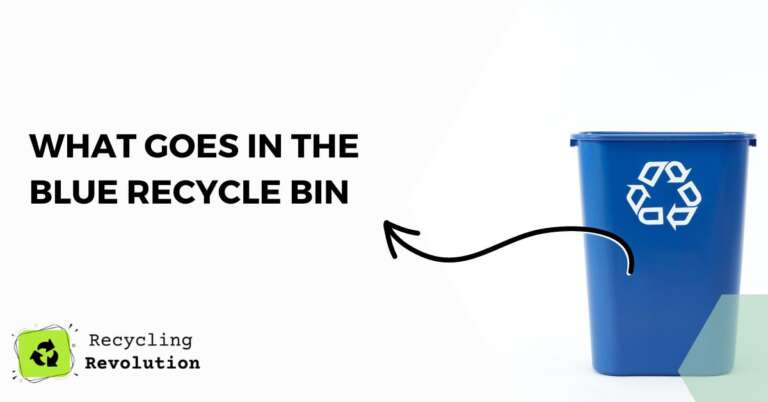TL;DR: Navigating the world of recycling can seem like a herculean task. But once you’ve got the hang of it, it’s as easy as pie! In the majority of places, the blue recycle bin is intended for clean and dry paper, cardboard, metal, glass, and plastic.
Always remember, when in doubt, consult your local recycling guidelines or, better yet, think of the three Rs: Reduce, Reuse, and Recycle.
Recycling 101: What Can I Put in My Blue Recycle Bin?
Before we dive deep into the materials that go into your blue bin, it’s crucial to remember that rules can vary. I recommend checking with your local waste management service for specifics.
That said, let’s cover some standard materials that are typically accepted in blue bins.
Paper and Cardboard
Paper is one of the most commonly recycled materials. From office paper to newspapers, magazines, and envelopes, if it’s paper, it likely belongs in the blue bin. But remember to keep it dry – wet paper can’t be recycled.
When it comes to cardboard, flat-packed cereal boxes, shipping boxes, and other forms of clean cardboard are all blue bin-ready. But again, it needs to be dry and free from food residue.
Note: Pizza boxes are a notorious exception due to their typical grease stains. If your pizza box is clean, recycle away! If not, it may be better suited for the compost bin.
Metal
Most metal food and drink cans can be recycled. Before tossing them in the bin, give them a quick rinse to remove any food or drink residue.
Glass
Glass bottles and jars, regardless of color, can go into the blue bin. However, not all glass is recyclable. For instance, items such as window glass, mirrors, and light bulbs should not go in the blue bin.
Plastics
Plastic recycling can be a bit complex because not all plastic is created equal. As a rule of thumb, you can recycle hard plastic containers like soda bottles, milk jugs, and detergent bottles in the blue bin.
However, avoid putting in plastic bags, plastic wrap, and styrofoam as these materials can’t be recycled curbside.
The Dirty Truth: Contamination
Even with the best intentions, improper recycling can lead to contamination, turning a whole batch of recyclables into waste.
Contamination often occurs when non-recyclables are placed in the blue bin, or when food or liquid residue is left on recyclable items. Always ensure your recyclables are clean, dry, and loose (not bagged) in the bin.
A Deeper Dive into Blue Bin Recycling
To successfully navigate the recycling process, a general understanding of what is allowed in the blue bin is just the beginning.
There are nuances to every category and it’s important to acknowledge these finer details, as they significantly contribute to the efficiency of recycling operations.
Mixed Materials: A Recycling Challenge
Mixed material items are those composed of different types of materials, often bonded together. For example, a juice carton might be made of both paper and plastic.
Note: These items are often not suitable for blue bin recycling, as separating the materials is complex and can be cost-prohibitive. It is beneficial to seek out specialized recycling programs for such items, or better yet, try to reduce your consumption of them in the first place.
Not All Plastics are Created Equal
As mentioned before, plastics are not a homogeneous group. They are categorized into seven types, each represented by a Resin Identification Code (RIC), which is usually found at the bottom of the plastic item within the familiar ‘chasing arrows’ symbol.
Typically, plastics #1 (PETE – Polyethylene Terephthalate) and #2 (HDPE – High-Density Polyethylene), which include most soda bottles, milk jugs, and detergent bottles, are accepted in the blue bin.
However, plastics #3 (PVC – Polyvinyl Chloride), #4 (LDPE – Low-Density Polyethylene), #5 (PP – Polypropylene), #6 (PS – Polystyrene), and #7 (Other – all other or mixed plastic), which include most plastic cutlery, bags, styrofoam, and other items, are generally not accepted in blue bins.
Note: It’s always wise to check the plastic type and consult your local guidelines to see which plastics are accepted in your area.
The Complications of Glass
While it’s easy to toss a glass bottle or jar in the blue bin, other types of glass pose challenges. Window glass, mirror glass, Pyrex, and other heat-resistant glass have different melting points compared to container glass, which can disrupt the recycling process.
Moreover, broken glass can pose a risk to the workers who sort the recyclables. If you have a broken glass item to dispose of, it’s often better to wrap it safely and put it in the regular trash, or seek out a specialized recycling program.
The Special Case of Aerosol Cans
Aerosol cans, like those used for whipped cream or air freshener, are made of metal and might seem like a good fit for the blue bin. However, due to the pressurized contents, they can present a risk if they are punctured or crushed.
If the aerosol can is completely empty, some recycling programs will accept them. But if the can isn’t fully empty, it could be considered hazardous waste and should be disposed of properly.
By understanding these intricacies, you are contributing significantly to making the recycling process more efficient and more beneficial for the environment.
Remember, recycling is not just about what can go into the bin, it’s about learning to reduce our waste and reuse wherever we can.
Beyond the Blue Bin
If you’re unable to put something in the blue bin, that doesn’t mean it’s destined for the landfill. Many items can be recycled through specialized programs. For example:
- Electronic waste, such as old computers and mobile phones, often have their own collection systems.
- Plastic bags and films can often be recycled at grocery stores.
- Batteries and light bulbs have unique recycling processes due to the chemicals they contain.
Conclusion
Recycling isn’t just about sorting trash. It’s about creating a sustainable future for our planet. By understanding what goes in the blue recycle bin, you’re taking a significant step in reducing waste and making a positive environmental impact. Remember, each effort counts. Make yours today!
FAQ
Can I recycle pizza boxes?
If the pizza box is clean and free of food or grease, you can recycle it. If it’s soiled, it’s best to compost it or dispose of it in the trash.
Can I put plastic bags in the blue recycle bin?
In most cases, no. Plastic bags can be recycled, but typically not through curbside programs. Many grocery stores have collection bins for plastic bags.
Can I recycle glass cookware or window glass in the blue bin?
No. While glass bottles and jars can be recycled, other types of glass like windows, mirrors, and cookware have different melting points and should not be mixed with recyclable glass.
Can I recycle dirty or wet paper?
No. Wet or soiled paper cannot be recycled as it contaminates the recycling process. Always ensure your paper is clean and dry before recycling.

